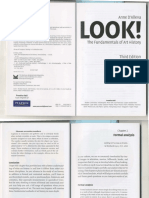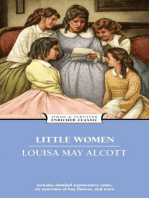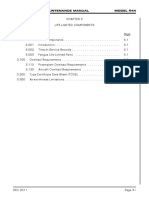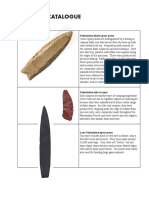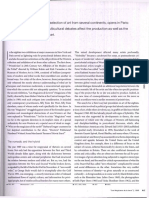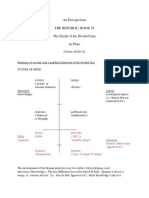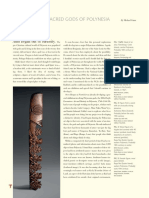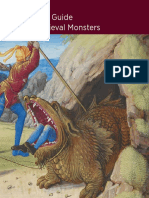Post Castration Evisceration: Clinical Commentary
Post Castration Evisceration: Clinical Commentary
Uploaded by
EmOriginal Title
Copyright
Available Formats
Share this document
Did you find this document useful?
Is this content inappropriate?
Report this DocumentCopyright:
Available Formats
Post Castration Evisceration: Clinical Commentary
Post Castration Evisceration: Clinical Commentary
Uploaded by
EmCopyright:
Available Formats
EQUINE VETERINARY EDUCATION / AE / NOVEMBER 2013 563
Clinical Commentary
Post castration evisceration
L. M. Getman
Tennessee Equine Hospital, Tennessee, USA.
Corresponding author email: libertygetman@gmail.com
Although uncommon, unfortunately post castration Luckily post castration evisceration is a rare event,
evisceration of small intestine through the vaginal ring does occurring in only 0.2–2.6% of castrations, but since it is likely to
occur. However, herniation of the small intestine through the be fatal without proper treatment, referral to a surgical facility
femoral canal following castration as reported by Torre et al. is always indicated (Moll et al. 1995; Thomas et al. 1998; May
(2013) in the current issue is extremely rare. This is the first report and Moll 2002; Shoemaker et al. 2004; Schumacher 2006). Like
to describe such a herniation fully and it provides a good the case reported by Torre et al. (2013), evisceration typically
reference for the clinical presentation, treatment, and occurs within 4–6 h after castration, but there are reports of it
outcome of such a hernia. It is interesting to note that this case occurring as late as 12 days after surgery (Thomas et al. 1998;
occurred in a horse of a breed that is not considered to be ‘at May and Moll 2002; Shoemaker et al. 2004; Schumacher 2006).
risk’ of herniating and after having a closed castration Risk factors include breed (Standardbreds and draught horses
performed with a ligature placed – a technique that is are over represented, and anecdotally Saddlebreds and
generally thought to prevent inguinal herniation (Schumacher Tennessee Walking Horses are also at increased risk),
2006). However, as this case illustrates, this technique would pre-existing inguinal hernias, the presence of an inguinal
not be expected to prevent herniation through other hernia as a foal, and an internal inguinal ring that is 2 or more
anatomical structures such as the femoral canal. In fingers wide on rectal palpation (Schumacher 2006). If a horse
agreement with the authors’ theory, it seems likely that the has any of these risk factors, it is recommended that the
femoral canal herniation was present at the time of admission scrotum be palpated carefully prior to castration to identify
to the referral centre due to the degree of damage present possible pre-existing inguinal hernias. Some authors also
within the entrapped portion of the small intestine that was recommend performing a rectal examination on at-risk horses
found at the second surgery. Had a ventral midline approach prior to castration to determine the size of the inguinal rings;
been used initially, this would probably have been identified. however, this is not always practical or safe. In the current
In hindsight, the large amount of swelling noted in the medial author’s opinion, any horse with the above risk factors should
thigh area at presentation may have been an indication that at least have ligatures placed around the cremaster muscle
this was not a ‘routine’ evisceration; however, in the author’s and spermatic cord separately (as the cremaster muscle adds
experience it is not unusual to note a fair amount of unilateral considerable bulk in mature horses, and contraction of this
swelling in the inguinal area in horses with post castration muscle can cause the ligature to loosen). If there is reason to
evisceration. believe that the horse has an excessively large inguinal ring,
The nomenclature used to describe inguinal hernias can then either surgical closure of the superficial inguinal ring or
be somewhat confusing and is inconsistently used throughout packing of the ring with gauze overnight should also be
the literature. Hernias that occur when a portion of intestine considered. It may also be beneficial to hospitalise at-risk
goes through the vaginal ring into the inguinal canal and horses overnight for careful observation and immediate
exiting to the scrotum are called scrotal or inguinal hernias. The identification of post operative evisceration.
herniated portion of intestine is still confined within the vaginal If post castration evisceration does occur, prompt
tunic with inguinal hernias and these hernias can be emergency care is essential for a successful outcome. Initial
congenital or acquired. When they are congenital there may therapy is aimed at keeping the bowel safe from damage and
not be any obvious clinical signs associated with them (until further contamination and preparing the horse for transport to
the horse is castrated). Acquired inguinal hernias cause post a referral centre. The protruding portion of bowel should be
castration evisceration in recently gelded horses or colic in cleaned of all gross contamination with sterile saline and then
stallions and rarely geldings. Although they are correctly replaced into the scrotum, which is sutured closed or closed
classified as ‘indirect’ hernias, this nomenclature is taken from with several towel clamps. If this is not possible – either due to
the human literature and is somewhat confusing. the amount of bowel that is prolapsed or lack of enough
If a herniated portion of intestine goes through the vaginal scrotal skin to do so – then a moist towel or drape should be
ring and inguinal canal but then passes through a rent in the made into a sling and used to support the bowel during
vaginal tunic to lie subcutaneously in the inguinal or scrotal transport. Alternately a hand towel can be sutured to the
area this is referred to as a ruptured inguinal hernia. This inguinal region to keep the bowel in place. The horse should
condition occurs more commonly in foals and is typically only be given sedation (if systemically stable), broad-spectrum i.v.
seen in adults due to trauma. Finally, inguinal rupture refers to antimicrobials, and flunixin meglumine for analgesic and
when a portion of intestine passes through a rent adjacent to antiendotoxic therapy. In some cases the horse will be painful
the vaginal ring. This has also been called a ‘direct’ hernia enough to require i.v. anaesthesia during transport. Once at a
again with reference to the human literature but this does surgical facility exploration by both an inguinal and ventral
not accurately describe the condition in horses, which is fairly midline approach is warranted, since a better determination
rare. of the health of the entire small intestine can be made by fully
© 2013 EVJ Ltd
564 EQUINE VETERINARY EDUCATION / AE / NOVEMBER 2013
exploring the intestinal tract. Survival rates following surgical Moll, H.D., Pelzer, K.D., Pleasant, R.S. and Modransky, P.D. (1995) A
treatment of intestinal evisceration range from 36–87%, with survey of equine castration complications. J. Equine Vet. Sci. 15,
522-526.
the lowest survival rates associated with an inguinal-only
surgical approach, increased length of prolapsed bowel, and Schumacher, J. (2006) Testis. In: Equine Surgery, Eds: J.A. Auer and J.A.
the need to perform a resection and anastomosis (Thomas Stick, Saunders Elsevier, St Louis. pp 775-810.
et al. 1998; Shoemaker et al. 2004). Shoemaker, R., Bailey, J., Zanzen, E. and Wilson, D.G. (2004) Routine
castration in 568 draught colts: incidence of evisceration and
Author’s declaration of interests omental herniation. Equine Vet. J. 36, 336-340.
No conflicts of interest have been declared. Thomas, H.L., Zaruby, J.F., Smith, C.L. and Livesey, M.A. (1998)
Postcastration eventration in 18 horses: the prognostic indicators for
References long-term survival (1985-1995). Can. Vet. J. 39, 764-768.
May, K.A. and Moll, H.D. (2002) Recognition and management of Torre, F., Gasparin, J. and Bassi Andreasi, M. (2013) Herniation of the
equine castration complications. Compend. Contin. Educ. Pract. small intestine through the femoral canal after castration in a
Vet. 24, 150-162. 3-year-old Thoroughbred. Equine Vet. Educ. 25, 558-562.
Continued from page 597
Heuchert, C.M., de Giulli, V., Jr, de Athaide, D.F., Böse, R. and Friedhoff, Rehbein, G., Zweygarth, E., Voigt, W.P. and Schein, E. (1982)
K.T. (1999) Seroepidemiologic studies on Babesia equi and Babesia Establishment of Babesia-equi-infected lymphoblastoid cell-lines.
caballi infections in Brazil. Vet. Parasit. 85, 1-11. Z. Parasitenkd. 67, 125-127.
Ikadai, H., Sasaki, M., Ishida, H., Matsuu, A., Igarashi, I., Fujisaki, K. and Rothschild, C. and Knowles, D. (2007) Equine piroplasmosis. In: Equine
Oyamada, T. (2007) Molecular evidence of Babesia equi Infectious Diseases, Eds: D.C. Sellon and M.T. Long, Saunders,
transmission in Haemaphysalis longicornis. Am. J. Trop. Med. Hyg. 76, Elsevier, St Louis. pp 465-473.
694-697. Schein, E. (1988) Equine babesiosis. In: Babesiosis of Domestic Animals
Knowles, D.P., Kappmeyer, L.S. and Perryman, L.E. (1994) Specific and Man, Ed: M. Ristic, CRC Press, Boca Raton. pp 197-208.
immune-responses are required to control parasitemia in Schein, E., Rehbein, G., Voigt, W.P. and Zweygarth, E. (1981) Babesia
Babesia-equi infection and immunity. Infect. Immun. 62, 1909-1913. equi (Laveran 1901). 1. Development in horses and in lymphocyte
Kuttler, K.L., Gipson, C.A., Goff, W.L. and Johnson, L.W. (1986) culture. Tropenmed. Parasitol. 32, 223-227.
Experimental Babesia-equi infection in mature horses. Am. J. Vet. Schwint, O.N., Ueti, M.W., Palmer, G.H., Kappmeyer, L.S., Hines, M.T.,
Res. 47, 1668-1670. Cordes, R.T., Knowles, D.P. and Scoles, G.A. (2009) Imidocarb
dipropionate clears persistent Babesia caballi infection with
Kuttler, K.L., Zaugg, J.L. and Gipson, C.A. (1987) Imidocarb and
elimination of transmission potential. Antimicrob. Agents Chemother.
parvaquone in the treatment of piroplasmosis (Babesia equi) in
53, 4327-4332.
equids. Am. J. Vet. Res. 48, 1613-1616.
Sevinc, F., Maden, M., Kumas, C., Sevinc, M. and Ekici, O.D. (2008) A
Mantran, A., Votion, D.M. and Amory, H. (2004) Piroplasmosis: a problem
comparative study on the prevalence of Theileria equi and Babesia
in Belgium? In: Proceedings of the Annual Congress Belgian Equine
caballi infections in horse sub-populations in Turkey. Vet. Parasitol.
Practitioners Society, Liège. http://www.ivis.org/proceedings/BEPS/
156, 173-177.
2004/Amory/chapter_frm.asp?LA=3.pdf (accessed 8 July 2013).
Shin, E.K., Perryman, L.E. and Meek, K. (1997) A kinase-negative
Maurer, F.D. (1962) Equine piroplasmosis - another emerging disease. mutation of DNA-PKCS in equine SCID results in defective coding
J. Am. Vet. Med. Ass. 141, 699-702. and signal joint formation. J. Immunol. 158, 3565-3569.
McGuire, T.C., Banks, K.L. and Poppie, M.J. (1975) Combined Sigg, L., Gerber, V., Gottstein, B., Doherr, M.G. and Frey, C.F. (2010)
immunodeficiency in horses - characterization of lymphocyte Seroprevalence of Babesia caballi and Theileria equi in the Swiss
defect. Clin. Immunol. Immunopathol. 3, 555-566. horse population. Parasitol. Int. 59, 313-317.
Mealey, R.H. et al. (2011) Equine piroplasmosis: concepts for treatment Tamzali, Y., Guelfi, J.F. and Braun, J.P. (2001) Plasma fibrinogen
and prevention. In: ACVIM Proceedings, Denver. pp 270-272. measurement in the horse: comparison of Millar’s technique with a
Mehlhorn, H. and Schein, E. (1998) Redescription of Babesia equi chronometric technique and the QBC-Vet Autoreader. Res. Vet. Sci.
(Laveran, 1901) as Theileria equi. Parasitol. Res. 84, 467-475. 71, 213-217.
Meyer, C., Guthrie, A.J. and Stevens, K.B. (2005) Clinical and Ueti, M.W., Palmer, G.H., Kappmeyer, L.S., Statdfield, M., Scoles, G.A.
clinicopathological changes in 6 healthy ponies following and Knowles, D.P. (2005) Ability of the vector tick Boophilus
intramuscular administration of multiple doses of imidocarb microplus to acquire and transmit Babesia equi following feeding on
dipropionate. J. S. Afr. Vet. Ass. 76, 26-32. chronically infected horses with low-level parasitemia. Clin.
Microbiol. 43, 3755-3759.
Moltmann, U.G., Mehlhorn, H., Schein, E., Rehbein, G., Voigt, W.P. and
Ueti, M.W., Mealey, R.H., Kappmeyer, L.S., White, S.N., Kumpula-
Zweygarth, E. (1983) Fine-structure of Babesia equi, Laveran 1901,
McWhirter, N., Pelzel, A.M., Grause, J.F., Bunn, T.O., Schwartz, A.,
within lymphocytes and erythrocytes of horses- an in vivo and in vitro
Traub-Dargatz, J.L., Hendrickson, A., Espy, B., Guthrie, A.J., Fowler,
study. J. Parasitol. 69, 111-120.
W.K. and Knowles, D.P. (2012) Reemergence of the apicomplexan
Moretti, A., Mangili, V., Salvatori, R., Maresca, C., Scoccia, E., Torina, A., Theileria equi in the United States: elimination of persistent infection
Moretta, I., Gabrielli, S., Tampieri, M.P. and Pietrobelli, M. (2010) and transmission risk. PLoS ONE 7, e44713.
Prevalence and diagnosis of Babesia and Theileria infections in
USDA-APHIS (2010a) Veterinary Services Equine Piroplasmosis Literature
horses in Italy: a preliminary study. Vet. J. 184, 346-350.
Review, September 2010. Available at: http://www.aphis.usda
Mujicaa, F.F., Perroneb, T., Forlanoa, M., Coronadoa, A., Meléndeza, .gov/animal_health/animal_diseases/piroplasmosis/downloads/ep_
R.D., Barriosc, N., Álvarezd, R. and Grandaa, F. (2011) Serological literature_review_september_2010.pdf (accessed 8 July 2013).
prevalence of Babesia caballi and Theileria equi in horses of Lara
USDA-APHIS (2010b) Veterinary Services Infosheet, Protecting your horses
State, Venezuela. Vet. Parasitol. 178, 180-183.
against Equine Piroplasmosis, April 2010. Available at: http://www
OIE (2008) Terrestrial manual, Volume 2 Chapter 2.5.8. Equine .aphis . usda . gov / animal _ health / animal _ diseases / piroplasmosis/
Piroplasmosis. Available at: http://www.oie.int/fileadmin/Home/ downloads/ep_protect_your_horses_en_sp.pdf (accessed 8 July
eng / Health _ standards / tahm / 2.05.08_EQUINE_PIROPLASMOSIS.pdf 2013).
(accessed 8 July 2013).
Wiler, R., Leber, R., Moore, B.B., VanDyk, L.F., Perryman, L.E. and Meek, K.
OIE (2013) OIE listed diseases. Available at: http://www.oie.int/en/ (1995) Equine severe combined immunodeficiency - a defect in
animal-health-in-the-world/oie-listed-diseases-2013 (accessed 8 V(D)J recombination and DNA-dependent protein-kinase activity.
July 2013). Proc. Natl. Acad. Sci. U.S.A. 92, 11485-11489.
Pitel, P.H., Pronost, S., Scrive, T., Léon, A., Richard, E. and Fortier, G. (2010) Zobba, R., Ardu, M., Niccolini, S., Chessa, B., Manna, L., Cocco, R. and
Molecular detection of Theileria equi and Babesia caballi in the Parpaglia, M.R.P. (2008) Clinical and laboratory findings in equine
bone marrow of asymptomatic horses. Vet. Parasitol. 170, 182-184. piroplasmosis. J. Equine Vet. Sci. 28, 301-308.
© 2013 EVJ Ltd
You might also like
- The Subtle Art of Not Giving a F*ck: A Counterintuitive Approach to Living a Good LifeFrom EverandThe Subtle Art of Not Giving a F*ck: A Counterintuitive Approach to Living a Good LifeRating: 4 out of 5 stars4/5 (5867)
- The Gifts of Imperfection: Let Go of Who You Think You're Supposed to Be and Embrace Who You AreFrom EverandThe Gifts of Imperfection: Let Go of Who You Think You're Supposed to Be and Embrace Who You AreRating: 4 out of 5 stars4/5 (1094)
- Never Split the Difference: Negotiating As If Your Life Depended On ItFrom EverandNever Split the Difference: Negotiating As If Your Life Depended On ItRating: 4.5 out of 5 stars4.5/5 (866)
- Grit: The Power of Passion and PerseveranceFrom EverandGrit: The Power of Passion and PerseveranceRating: 4 out of 5 stars4/5 (597)
- Hidden Figures: The American Dream and the Untold Story of the Black Women Mathematicians Who Helped Win the Space RaceFrom EverandHidden Figures: The American Dream and the Untold Story of the Black Women Mathematicians Who Helped Win the Space RaceRating: 4 out of 5 stars4/5 (909)
- Shoe Dog: A Memoir by the Creator of NikeFrom EverandShoe Dog: A Memoir by the Creator of NikeRating: 4.5 out of 5 stars4.5/5 (543)
- The Hard Thing About Hard Things: Building a Business When There Are No Easy AnswersFrom EverandThe Hard Thing About Hard Things: Building a Business When There Are No Easy AnswersRating: 4.5 out of 5 stars4.5/5 (352)
- Elon Musk: Tesla, SpaceX, and the Quest for a Fantastic FutureFrom EverandElon Musk: Tesla, SpaceX, and the Quest for a Fantastic FutureRating: 4.5 out of 5 stars4.5/5 (474)
- Her Body and Other Parties: StoriesFrom EverandHer Body and Other Parties: StoriesRating: 4 out of 5 stars4/5 (824)
- The Emperor of All Maladies: A Biography of CancerFrom EverandThe Emperor of All Maladies: A Biography of CancerRating: 4.5 out of 5 stars4.5/5 (272)
- The Sympathizer: A Novel (Pulitzer Prize for Fiction)From EverandThe Sympathizer: A Novel (Pulitzer Prize for Fiction)Rating: 4.5 out of 5 stars4.5/5 (122)
- The Little Book of Hygge: Danish Secrets to Happy LivingFrom EverandThe Little Book of Hygge: Danish Secrets to Happy LivingRating: 3.5 out of 5 stars3.5/5 (411)
- The Yellow House: A Memoir (2019 National Book Award Winner)From EverandThe Yellow House: A Memoir (2019 National Book Award Winner)Rating: 4 out of 5 stars4/5 (98)
- The World Is Flat 3.0: A Brief History of the Twenty-first CenturyFrom EverandThe World Is Flat 3.0: A Brief History of the Twenty-first CenturyRating: 3.5 out of 5 stars3.5/5 (2268)
- Devil in the Grove: Thurgood Marshall, the Groveland Boys, and the Dawn of a New AmericaFrom EverandDevil in the Grove: Thurgood Marshall, the Groveland Boys, and the Dawn of a New AmericaRating: 4.5 out of 5 stars4.5/5 (268)
- Team of Rivals: The Political Genius of Abraham LincolnFrom EverandTeam of Rivals: The Political Genius of Abraham LincolnRating: 4.5 out of 5 stars4.5/5 (235)
- A Heartbreaking Work Of Staggering Genius: A Memoir Based on a True StoryFrom EverandA Heartbreaking Work Of Staggering Genius: A Memoir Based on a True StoryRating: 3.5 out of 5 stars3.5/5 (232)
- D'Alleva, Look: The Fundamentals of Art HistoryDocument13 pagesD'Alleva, Look: The Fundamentals of Art HistoryEm100% (1)
- Realist ManifestoDocument7 pagesRealist ManifestoEmNo ratings yet
- On Fire: The (Burning) Case for a Green New DealFrom EverandOn Fire: The (Burning) Case for a Green New DealRating: 4 out of 5 stars4/5 (74)
- Dymind DH36 - Operator's ManualDocument195 pagesDymind DH36 - Operator's ManualДенис Сахно80% (5)
- Lesson Plan 5 - Oblique Pictorial DrawingDocument10 pagesLesson Plan 5 - Oblique Pictorial DrawingJoceme CRISTORIA100% (1)
- Meyer Schapiro The Still Life As A Personal ObjectDocument5 pagesMeyer Schapiro The Still Life As A Personal ObjectEmNo ratings yet
- Self Portrait: Renaissance To Contemporary Education KitDocument23 pagesSelf Portrait: Renaissance To Contemporary Education KitEm100% (2)
- The Unwinding: An Inner History of the New AmericaFrom EverandThe Unwinding: An Inner History of the New AmericaRating: 4 out of 5 stars4/5 (45)
- r44 - MM - 3 LIFE-LIMITED COMPONENTSDocument14 pagesr44 - MM - 3 LIFE-LIMITED COMPONENTSSiswadi100% (1)
- ArtifactcatalogueDocument8 pagesArtifactcatalogueEmNo ratings yet
- Foster Hal Et Al Art Since 1900 1989Document7 pagesFoster Hal Et Al Art Since 1900 1989EmNo ratings yet
- An Excerpt From Book VI of Plato's RepublicDocument4 pagesAn Excerpt From Book VI of Plato's RepublicEmNo ratings yet
- Codex CalixtinusDocument28 pagesCodex CalixtinusEmNo ratings yet
- Atua Sacred Gods of Polynesia by Michael Gunn From Tribal Art MagazineDocument8 pagesAtua Sacred Gods of Polynesia by Michael Gunn From Tribal Art MagazineEmNo ratings yet
- Guggenheim Education Hilma Af Klint Teacher Resource Unit 10 5Document16 pagesGuggenheim Education Hilma Af Klint Teacher Resource Unit 10 5EmNo ratings yet
- Published: December 29, 1878Document1 pagePublished: December 29, 1878EmNo ratings yet
- Medieval Monsters Web GuideDocument9 pagesMedieval Monsters Web GuideEm100% (1)
- Click Here To See The Painting!Document7 pagesClick Here To See The Painting!EmNo ratings yet
- Lorenzo Ghiberti PDFDocument8 pagesLorenzo Ghiberti PDFEm100% (1)
- Chinese Calligraphy PDFDocument9 pagesChinese Calligraphy PDFEm100% (1)
- (Tutorial) Root - Xperia 4.0.4 ROM (All H - M (Dpi) ) - 4.1.B.0.431 (23st June) - Xda-DevelopersDocument8 pages(Tutorial) Root - Xperia 4.0.4 ROM (All H - M (Dpi) ) - 4.1.B.0.431 (23st June) - Xda-DevelopersGiovz G de GuzmanNo ratings yet
- Ont Dual Band: Características PrincipalesDocument2 pagesOnt Dual Band: Características PrincipalesJesus Vallarin QuirozNo ratings yet
- Further Reduced ISC Class 12 English Syllabus 2020 21Document7 pagesFurther Reduced ISC Class 12 English Syllabus 2020 21Saumya ChandraNo ratings yet
- Mhada - Maharashtra.gov - in Sites Default Files Agreement For NOC From LADocument10 pagesMhada - Maharashtra.gov - in Sites Default Files Agreement For NOC From LArajivkvoraNo ratings yet
- User Manual: - Installation - OperationDocument76 pagesUser Manual: - Installation - OperationKasun WeerasingheNo ratings yet
- STM-1 Mux Sonet/Sdh Multiplexer: User ManualDocument30 pagesSTM-1 Mux Sonet/Sdh Multiplexer: User ManualViswanath ReddyNo ratings yet
- Concrete Dams Case Histories of Failures and Nonfailures With Back CalculationsDocument100 pagesConcrete Dams Case Histories of Failures and Nonfailures With Back Calculationswendydy6No ratings yet
- AppendixDocument11 pagesAppendixVishal PatadiaNo ratings yet
- Conclusion: Respectful Reader!Document12 pagesConclusion: Respectful Reader!مروان الحاسيNo ratings yet
- CFPA ECHO Balance - LoadingDocument21 pagesCFPA ECHO Balance - Loadingm.1990.williamsNo ratings yet
- Written Report ForDocument3 pagesWritten Report ForMark Angelo Manuel ElduayanNo ratings yet
- Ni P F Year Per I Year N IDocument5 pagesNi P F Year Per I Year N IRyan CalicaNo ratings yet
- 06 MCTDocument100 pages06 MCTSompon ModekamNo ratings yet
- Realization Time HistogramDocument2 pagesRealization Time HistogramAndreea HavrișciucNo ratings yet
- Memo 097.9 082321 Internal Quality Audit IQA CY 2021 Advisory No.2Document4 pagesMemo 097.9 082321 Internal Quality Audit IQA CY 2021 Advisory No.2David CastilloNo ratings yet
- Semi-Integrated SOG/TEOS Etchback Process For Multimetal Submicron DevicesDocument4 pagesSemi-Integrated SOG/TEOS Etchback Process For Multimetal Submicron DevicesJohn KikidisNo ratings yet
- Change ManagementDocument41 pagesChange ManagementuzaimyNo ratings yet
- Unit - 2 Stresses and Strains in Flexible PavementsDocument11 pagesUnit - 2 Stresses and Strains in Flexible Pavementsguru civil100% (1)
- 03.E. Airworthiness RequirementsDocument6 pages03.E. Airworthiness RequirementsUDAYAPRAKASH RANGASAMYNo ratings yet
- rx330 Gasoline 106Document2 pagesrx330 Gasoline 106Андрей СилаевNo ratings yet
- TCZ 2Document3 pagesTCZ 2vijay rajputNo ratings yet
- Moving Coil Instruments: L I B N FDocument31 pagesMoving Coil Instruments: L I B N Faurellia moNo ratings yet
- Smocking and Advanced Smocking MachineDocument16 pagesSmocking and Advanced Smocking MachineSalman SiamNo ratings yet
- Easy Chicken Tikka MasalaDocument2 pagesEasy Chicken Tikka MasalaAmoy Pixel NicholsonNo ratings yet
- Project Z Survivors Guide PDFDocument9 pagesProject Z Survivors Guide PDFBladiebla84No ratings yet
- Lesson #15 - Percent ProblemsDocument10 pagesLesson #15 - Percent ProblemsMR.ENo ratings yet
- Requirement List For Co-Operative Bank AuditDocument7 pagesRequirement List For Co-Operative Bank AuditVivek Jani100% (3)
































